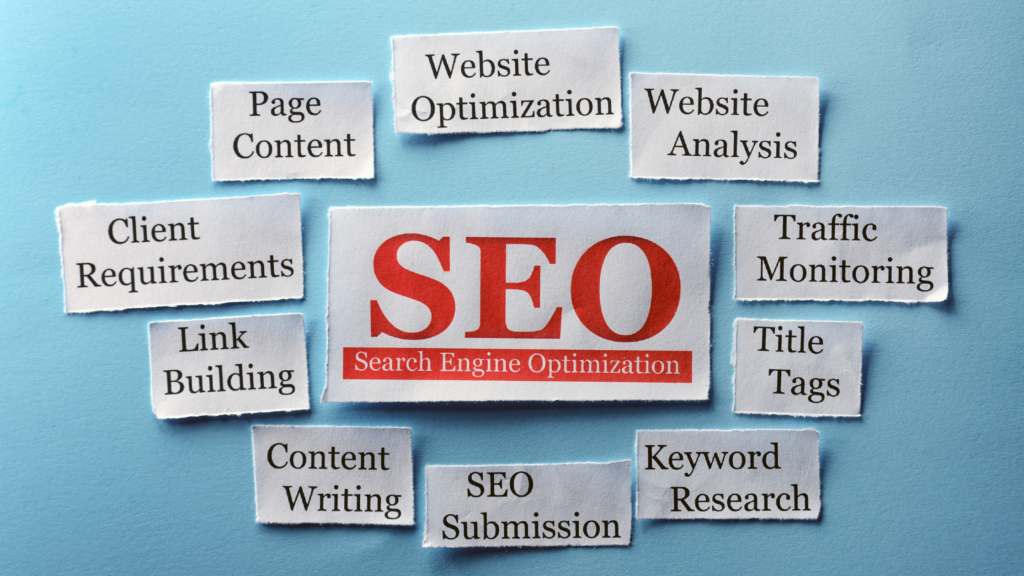In today’s digital world, SEO is more than just a marketing buzzword—it’s the foundation of online visibility. Whether you run a blog, manage an e-commerce site, or promote a local business, understanding the SEO basics can give you a powerful edge in the competitive landscape of search engines. SEO ensures that your content, products, or services are found by the right audience at the right time.
If you’ve ever wondered what SEO actually is, why it matters, and how it helps your business grow, this guide is for you. Let’s break down everything you need to know about SEO in a way that’s simple, actionable, and beginner-friendly.

What Is SEO?
SEO (Search Engine Optimization) is the process of improving your website’s visibility on search engines like Google, Bing, or Yahoo. When someone enters a search query, search engines scan and rank content to deliver the most relevant results. The better your SEO, the higher your website ranks when someone searches for topics related to your content or business.
Think of SEO as the digital equivalent of placing your business in a busy street rather than a hidden alley. With strong SEO, your site gets discovered easily, resulting in more traffic, engagement, and ultimately conversions.
Why Should You Do SEO?
Most online experiences begin with a search engine. If your website isn’t optimized, you’re missing out on a massive portion of potential traffic and customers. Here’s why SEO is worth your time:
- Visibility: SEO boosts your website’s presence in search results, increasing your chances of being seen by potential customers.
- Trust: High-ranking websites are generally perceived as more credible and trustworthy.
- Cost-Effective: Unlike paid ads, organic traffic driven by SEO doesn’t require you to pay for each visitor.
- Targeted Traffic: SEO attracts users who are actively searching for what you offer, making them more likely to convert.
SEO isn’t a one-time task; it’s a continuous process that evolves with search engine algorithms and user behavior.
Why Is SEO Important?
SEO is vital for businesses of all sizes. Without it, even the most beautiful and well-designed websites can go unnoticed. When your website appears higher in search engine results:
- More people find and trust your brand.
- You receive a consistent flow of high-quality traffic.
- You reduce your dependency on costly advertising.
- Your authority in the industry strengthens over time.
SEO ensures that your digital content reaches the right people, which is essential for building brand awareness, credibility, and growth.

Benefits of SEO
Here are some compelling benefits of implementing SEO:
- Increased Traffic: SEO brings more organic visitors to your site, which often translates into more leads or sales.
- Higher ROI: SEO delivers long-term results and offers one of the best returns on marketing investment.
- Improved User Experience: SEO-friendly sites load faster, are mobile-responsive, and provide a seamless browsing experience.
- Builds Authority: With regular content creation and backlinking, your site gains credibility.
- Better Conversion Rates: SEO brings in users who are actively searching for your product or service, leading to better engagement and conversions.
How SEO Helps Grow a Business
A solid strategy can significantly impact business growth by:
- Lead Generation: Attracts users who are actively searching for your offerings.
- Brand Awareness: The higher your rank, the more people become familiar with your business.
- Long-Term Strategy: builds long-term brand equity and traffic.
- Competitive Advantage: Staying ahead of competitors who neglect SEO.
- Improved Sales Funnel: Guides prospects through the customer journey—from awareness to conversion.
Types of SEO (With Full Breakdown)

1. On-Page SEO
Meaning: On-page SEO involves optimizing individual web pages to improve their search visibility and relevance. It focuses on both the content and the HTML source code of a page.
Key Factors:
- Title Tags: Appear in search results as clickable headlines. Should include the main keyword and be engaging.
- Meta Descriptions: A short summary below your title tag in search results. Helps increase click-through rate.
- Header Tags: Use H1 for the main heading, and H2-H6 for subheadings to organize content structure.
- Keyword Usage: Place primary keywords naturally in titles, subheadings, and throughout the content.
- Image Alt Text: Descriptive tags that help search engines understand images.
- URL Structure: Should be clean, readable, and include target keywords.
- Internal Linking: Links to other pages within your website to help users and search engines navigate.
- Mobile Responsiveness: Your site must be easy to use on all screen sizes.
- Page Speed: Faster pages lead to better user experience and rankings.
Why It Helps: On-page SEO increases relevancy, improves readability, and enhances user engagement—all of which impact rankings.
How to Perform:
- Start with keyword research.
- Structure content using H1, H2, and H3 tags.
- Use images, internal links, and optimized metadata.
Tools:
- Yoast SEO: WordPress plugin for optimizing on-page content.
- Surfer SEO: Helps compare your page to competitors and gives real-time optimization tips.
- Google PageSpeed Insights: Analyzes page speed and provides suggestions for improvement.
2. Off-Page SEO
Meaning: Off-page refers to optimization strategies that happen outside of your website to boost your rankings.
Key Factors:
- Backlinks: Links from other reputable websites to yours. Acts as a vote of confidence.
- Social Signals: Likes, shares, and mentions on social media platforms.
- Brand Mentions: When your brand is mentioned on forums, news outlets, or blogs.
- Guest Blogging: Publishing content on external sites to build authority and gain backlinks.
- Influencer Outreach: Collaborating with influencers to increase your reach and reputation.
Why It Helps: Off-page SEO builds trust and authority—key components of Google’s ranking algorithm.
How to Perform:
- Outreach for backlinks by offering valuable content.
- Promote your content on social platforms.
- Collaborate with industry influencers.
Tools:
- Ahrefs: Tracks backlinks, analyzes competitors, and finds link-building opportunities.
- SEMrush: Comprehensive SEO suite that includes backlink analysis and outreach tools.
- BuzzSumo: Helps find popular content and influencers in your niche.
- HARO (Help A Reporter Out): Connects you with journalists for brand mentions.
3. Technical SEO
Meaning: Technical SEO ensures your site meets the technical requirements of modern search engines for better indexing and crawling.
Key Factors:
- Site Speed: Faster loading websites improve user experience and reduce bounce rates.
- Mobile Optimization: Your site must work well on smartphones and tablets.
- HTTPS Encryption: Secure sites (using SSL certificates) are prioritized in search results.
- XML Sitemap: Helps search engines navigate and index your site.
- Robots.txt File: Tells search engines which pages to crawl and which to ignore.
- Canonical Tags: Prevents duplicate content issues by pointing search engines to the preferred version of a page.
- Structured Data (Schema Markup): Helps search engines understand your content and display rich snippets.
- Fixing Crawl Errors: Ensures all your pages are accessible and error-free.
Why It Helps: Improves the accessibility and structure of your site, making it easier for search engines to understand and rank your pages.
How to Perform:
- Audit your site using technical tools.
- Fix broken links and duplicate content.
- Ensure crawlability and indexing are error-free.
Tools:
- Screaming Frog: Crawls your website to find technical issues like broken links and redirects.
- GTmetrix: Analyzes speed performance and gives optimization recommendations.
- Google Search Console: Monitors your site’s presence in Google and highlights technical errors.
4. Local SEO
Meaning: Local SEO focuses on optimizing your online presence for location-specific search results, especially beneficial for brick-and-mortar businesses.
Key Factors:
- Google Business Profile Optimization: Complete and accurate info increases visibility in local searches.
- Consistent NAP (Name, Address, Phone Number): Must be identical across all directories.
- Local Keywords: Include location-based terms (e.g., “best coffee shop in Austin”).
- Positive Reviews: Encourage customers to leave reviews on platforms like Google and Yelp.
- Directory Citations: Listings in local directories like Yellow Pages or Yelp.
Why It Helps: Captures local intent searches like “near me” or “[service] in [city]”.
How to Perform:
- Optimize and verify your Google Business Profile.
- Collect local reviews and respond to them.
- Submit business info to online directories.
Tools:
- Moz Local: Ensures consistent business listings across the web.
- BrightLocal: Tracks local rankings, reviews, and citations.
- Whitespark: Helps with citation building and local SEO audits.
Understanding Search Intent
Search intent refers to the reason behind a user’s search query. It is classified into four types:
- Informational: User is looking for information (e.g., “what is SEO?”).
- Navigational: User is looking for a specific website (e.g., “Facebook login”).
- Transactional: User intends to make a purchase (e.g., “buy running shoes online”).
- Commercial Investigation: User is comparing products/services (e.g., “best SEO tools 2024”).
Understanding and targeting the right search intent helps create content that satisfies user needs and improves rankings.
SEO vs SEM: What’s the Difference?
While SEO focuses on organic search, SEM (Search Engine Marketing) includes paid search strategies like Google Ads. Key differences:
- SEO: Long-term strategy, free traffic, builds authority over time.
- SEM: Paid traffic, immediate results, requires ongoing investment.
Combining both can maximize visibility and ROI.
Content Marketing and SEO
Content is the backbone of Search Engine Optimization. Quality content drives traffic, earns backlinks, and keeps users engaged. To succeed:
- Create evergreen content that stays relevant.
- Use blog posts, infographics, videos, and case studies.
- Focus on keyword-rich, valuable, and user-intent-aligned topics.
E-A-T: Expertise, Authoritativeness, Trustworthiness
E-A-T is a concept introduced by Google’s Quality Rater Guidelines to evaluate content quality. To boost E-A-T:
- Publish author bios and credentials.
- Get mentions from reputable sites.
- Secure your website with HTTPS.
- Encourage reviews and testimonials.
SEO for Voice Search
With the rise of virtual assistants, optimizing for voice search is crucial. Tips:
- Use conversational keywords.
- Create FAQ pages.
- Optimize for featured snippets.
How to Perform (Step-by-Step Recap)
- Conduct Keyword Research using Ahrefs, Ubersuggest, or Google Keyword Planner.
- Create High-Quality Content that satisfies user intent.
- On-Page Optimization including metadata, internal linking, and media.
- Technical enhancements include mobile responsiveness, site speed, and structured data.
- Link Building & Outreach to gain domain authority.
- Monitor Performance using analytics and SEO tools to refine your strategy.

Best Tools for Success (Explained)
- Google Search Console: Monitors your site’s presence in Google search and reports indexing issues.
- Google Analytics: Tracks website performance, traffic sources, user behavior, and conversion paths.
- Yoast/ Rank Math: Plugins for WordPress to optimize metadata, readability, and keyword usage.
- Ahrefs / SEMrush: Powerful SEO suites for backlink analysis, keyword research, and competitor tracking.
- Screaming Frog: A desktop crawler that audits technical SEO issues.
- Moz & BrightLocal: Local SEO tools that manage listings and track rankings in specific regions.
- Ubersuggest: Keyword research and SEO audit tool with a user-friendly interface.
- AnswerThePublic: Generates questions and topics people are searching for, useful for content planning.
Final Thoughts
Getting started with this technique may seem overwhelming, but it becomes manageable when broken down into actionable steps. Focus on creating useful content, optimizing each page, and making your site user-friendly.
Remember, this is a marathon, not a sprint. But with consistency and the right strategy, your efforts will pay off with higher rankings, more traffic, and greater business growth.
Conclusion
SEO is no longer optional in today’s competitive digital landscape—it’s essential. From increasing visibility and building trust to generating leads and driving sales, it has the power to transform your online presence. By understanding and applying all four types of SEO—on-page, off-page, technical, and local—you can build a well-rounded, future-proof strategy that helps your business thrive.
Use the right tools, stay updated with algorithm changes, and always focus on delivering value to your audience. When done correctly, SEO not only drives traffic but also converts visitors into loyal customers. Start now, and set your brand on the path to long-term success.
No matter what industry you’re in, SEO can help you reach your goals faster, more effectively, and with measurable results. Make SEO your priority today, and your digital presence will thank you tomorrow!
Craving more content? Dive into our other blogs on this page.
Liked what you read? Let us help you grow — check out our digital marketing services today! Visit Our Website

